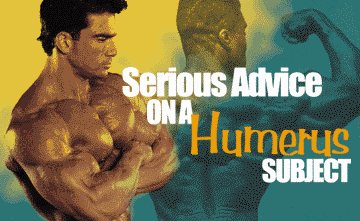 |
|||
| (Company's Profile) | (Editor talk) | ||
| (Q&A) | (Featured Articles) | ||
|
(Registration, Company's conditions & guidelines)
|
|||
| Featured Article (Posted Bi-Monthly): |
|
A Little Work on Some Small
Muscles Can Make a By Charles Poliquin
The monster whirlwinds in Twister destroyed cities, made pigs fly (along with other farm animals), and gave Helen Hunt some really bad hair days. The aliens in Independence Day, who looked like giant squids, attempted to exterminate the human race with their mile-long war machines. Not unlike mainstream America's obsession with action movies that blow everything out of proportion, some bodybuilders obsess with adding jaw-dropping special effects to their physiques in the form of slab after slab of rock-hard muscle. With all due respect to the aesthetics of a Frank Zane physique, in the bodybuilding world, some people equate bigger with better. Unfortunately, our obsession with developing big showy muscles often results in our neglecting important smaller muscles. Included in this neglected group are the muscles that externally rotate the shoulders. When I speak about external rotation of the shoulder, I'm referring to the motion of moving the biceps away from the body or simply backwards. The follow-through on a blistering Pete Sampras backhand is an example of external rotation. Although many muscles are involved in this motion, the two most important muscles are the teres minor and the infraspinatus. These muscles lie adjacent to each other and originate on the scapula (shoulder blade) and insert in the humerus (the long bone in the upper arm) and comprise two of the four muscles known as the rotator cuff. From a biomechanical perspective, the teres minor and the infraspinatus help stabilize the shoulder and are therefore crucial for protecting this area from injury. Who Should Train the External Rotators?
Dan Pfaff is the trainer of Olympic gold medalist and world record holder Donovan Bailey. Bailey underwent Active Release Techniques just prior to the Atlanta Olympics. Pfaff knows the importance of such treatments, stating, "There is a very fine line between physiotherapy and the training of the elite athlete." What he means is that when training high-performance athletes, special attention must be given to keeping the body healthy. When I design off-season workouts for athletes, my first priority is to correct the muscular imbalances that develop from all the specific training that occurs within the athlete's particular sport. Take the example of an alpine skier: the top priority in the off-season would be to have him or her perform exercises for the hamstrings to balance the quad strength developed from skiing. Some caution here: this is not to be confused with "crosstraining," a term that has become a popular buzzword in athletics. One of the claims of the crosstraining philosophy is that by participating in a variety of activities, athletes will help prevent muscle imbalances and therefore prolong their competitive careers. Unfortunately, most athletes who crosstrain participate in sports that are biomechanically very similar, thereby perpetuating muscle imbalances rather than correcting them. This mistake, plus the fact that few sports work the external rotators extensively, makes this an area of concern. The following are people who probably need to pay special attention to the external rotators:
Bodybuilders who do a lot of work for their pecs or lats.
Bodybuilders striving for the ultimate in back development.
Individuals who want to increase their bench press.
Individuals with rounded shoulders. Athletes
in sports where the lats or pecs are the prime movers. Based on the above prerequisites, the most likely candidate for supplementary work on the external rotators is a tall bench-press fanatic who plays volleyball and is employed as a computer programmer. (There's one in every crowd, you know.)
|
|
Email: hbiomechanics@yahoo.com
|
